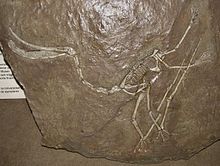
Summary
Euctenochasmatia is an extinct group of pterodactyloid pterosaurs. It was named by David Unwin in 2003 as the group that contains the most recent common ancestor of Pterodactylus and Ctenochasma, and all their descendants.[1]
| Euctenochasmatians Temporal range: Late Jurassic - Early Cretaceous,
| |
|---|---|

| |
| Cast of the sub-adult type specimen of the basal member Pterodactylus antiquus | |

| |
| Cast of fossil specimen of the ctenochasmatid Pterodaustro guinazui | |
| Scientific classification | |
| Domain: | Eukaryota |
| Kingdom: | Animalia |
| Phylum: | Chordata |
| Order: | †Pterosauria |
| Suborder: | †Pterodactyloidea |
| Infraorder: | †Archaeopterodactyloidea |
| Clade: | †Euctenochasmatia Unwin, 2003 |
| Subgroups | |
Euctenochasmatians were specialized pterosaurs that had elongated necks as well as specialized teeth. A peculiar family within this group is the Ctenochasmatidae, which most of the members had very distinguishing teeth that were lined within their elongated snouts.[2] A genus called Pterofiltrus only had 112 teeth, but these teeth cover about 55.8% of the total skull, and the skull itself measured about 208 millimeters (8.2 in) in length.[3]
Description edit
Euctenochasmatians had very distinctive features in comparison to other pterosaurs, including the shape of their jaws, as well as their highly specialized teeth. These teeth are thought to have been used for filter-feeding, the genus Pterodaustro for example, had a long snout and its lower jaws curve strongly upwards, and the tangent at the point of the snout was perpendicular to that of the jaw joint. Pterodaustro has around a thousand baleen-like teeth in its lower jaws that might have been used to strain crustaceans, plankton, algae, and other small creatures from the water. The teeth of Pterodaustro are unique within pterosaurs, and no other discovered genera had this type of teeth.[4][5]
Other members of this group, such as the gallodactylids, differ from other euctenochasmatians in several distinct features, including having fewer than 50 teeth, and were only present in the jaw tips; rounded crests were also present on the rear portion of the skull and jaws but not near the ends of their snouts.[6] Similarly, the ctenochasmatid Feilongus also had its teeth confined within its jaw tips, as well as having crests on the rear portion of the skull and jaws, but differed Feilongus from the gallodactylids by having a possible pronounced overbite, and 76 teeth, which were needle-like.[7]
One of the largest toothed pterosaurs was Moganopterus, it was, yet again, a ctenochasmatid, and was similar in build to Feilongus. What made Moganopterus distinct was its size; while Feilongus had a wingspan of about 2.4 meters (7.9 ft), Moganopterus had an impressive wingspan of more than 7 meters (23 ft), making it more than three times larger than Feilongus.[8]
Classification edit
Researchers such as David Unwin, have traditionally defined the dubious family Pterodactylidae in such a way to ensure it is nested within the clade Ctenochasmatoidea. In 2003, Unwin defined the same clade (Pterodactylus + Pterodaustro), but erected the name Euctenochasmatia instead of Pterodactylidae for his conclusion.[9] Unwin had considered Euctenochasmatia to be a subgroup within Ctenochasmatoidea, similar to his former conclusion of Pterodactylidae, but most analyses have since found the genus Pterodactylus to be more primitive than previously thought, making the clade Euctenochasmatia the more inclusive group containing both Pterodactylus and Ctenochasmatoidea.[10]
Below is cladogram following a topology recovered by Brian Andres, using the most recent iteration of his data set (Andres, 2021). Andres' analysis found Pterodactylus to be a close relative of the ctenochasmatoids.[11]
| Pterodactyloidea |
| ||||||||||||
Earlier, in 2017, Steven Vidovic and David Martill had recovered a significantly different set of relationships for early pterodactyloids. They placed Pterodactylus outside Euctenochasmatia, as the sister taxon of the more inclusive group Lophocratia.[1]
References edit
- ^ a b Vidovic, S.U.; Martill, D.M. (2017). "The taxonomy and phylogeny of Diopecephalus kochi (Wagner, 1837) and "Germanodactylus rhamphastinus" (Wagner, 1851)". Geological Society, London, Special Publications. 455: 125–147. doi:10.1144/SP455.12. S2CID 219204038.
- ^ Wilton, Mark P. (2013). Pterosaurs: Natural History, Evolution, Anatomy. Princeton University Press. ISBN 978-0691150611.
- ^ Jiang Shunxing and Wang Xiaolin (2011). "A new ctenochasmatid pterosaur from the Lower Cretaceous, western Liaoning, China" (PDF). Anais da Academia Brasileira de Ciências. 83 (4): 1243–1249. doi:10.1590/s0001-37652011000400011. ISSN 0001-3765. PMID 22146956.
- ^ Chinsamy, A., Codorniú, L., and Chiappe, L. M. (2008). "Developmental growth patterns of the filter-feeder pterosaur, Pterodaustro guinazui". Biology Letters. 4 (3): 282–285. doi:10.1098/rsbl.2008.0004. PMC 2610039. PMID 18308672.
{{cite journal}}: CS1 maint: multiple names: authors list (link) - ^ Wellnhofer, Peter (1996) [1991]. The Illustrated Encyclopedia of Pterosaurs. New York: Barnes and Noble Books. p. 132. ISBN 0-7607-0154-7.
- ^ Bennett, S. C. (2013). "The morphology and taxonomy of the pterosaur Cycnorhamphus". Neues Jahrbuch für Geologie und Paläontologie - Abhandlungen. 267: 23–41. doi:10.1127/0077-7749/2012/0295.
- ^ Wang X, Shen C, Gao C, Jin K (February 2014). "New Material of Feilongus (Reptilia: Pterosauria) from the Lower Cretaceous Jiufotang Formation of Western Liaoning". Acta Geologica Sinica - English Edition. 88 (1): 13–7. doi:10.1111/1755-6724.12178. S2CID 129439258.
- ^ Lü Junchang; Pu Hanyong; Xu Li; Wu Yanhua; Wei Xuefang (2012). "Largest Toothed Pterosaur Skull from the Early Cretaceous Yixian Formation of Western Liaoning, China, with Comments On the Family Boreopteridae". Acta Geologica Sinica. 86 (2): 287–293. doi:10.1111/j.1755-6724.2012.00658.x. S2CID 130163272.
- ^ Unwin, D. M. (2003). "On the phylogeny and evolutionary history of pterosaurs". Geological Society, London, Special Publications. 217 (1): 139–190. Bibcode:2003GSLSP.217..139U. CiteSeerX 10.1.1.924.5957. doi:10.1144/GSL.SP.2003.217.01.11. S2CID 86710955.
- ^ Witton, Mark P. (2013). Pterosaurs: Natural History, Evolution, Anatomy. Princeton University Press. ISBN 0691150613.
- ^ Andres, B. (2021) Phylogenetic systematics of Quetzalcoatlus Lawson 1975 (Pterodactyloidea: Azhdarchoidea). Journal of Vertebrate Paleontology, 41:sup1, 203-217. DOI: 10.1080/02724634.2020.1801703 https://www.tandfonline.com/doi/full/10.1080/02724634.2020.1801703


